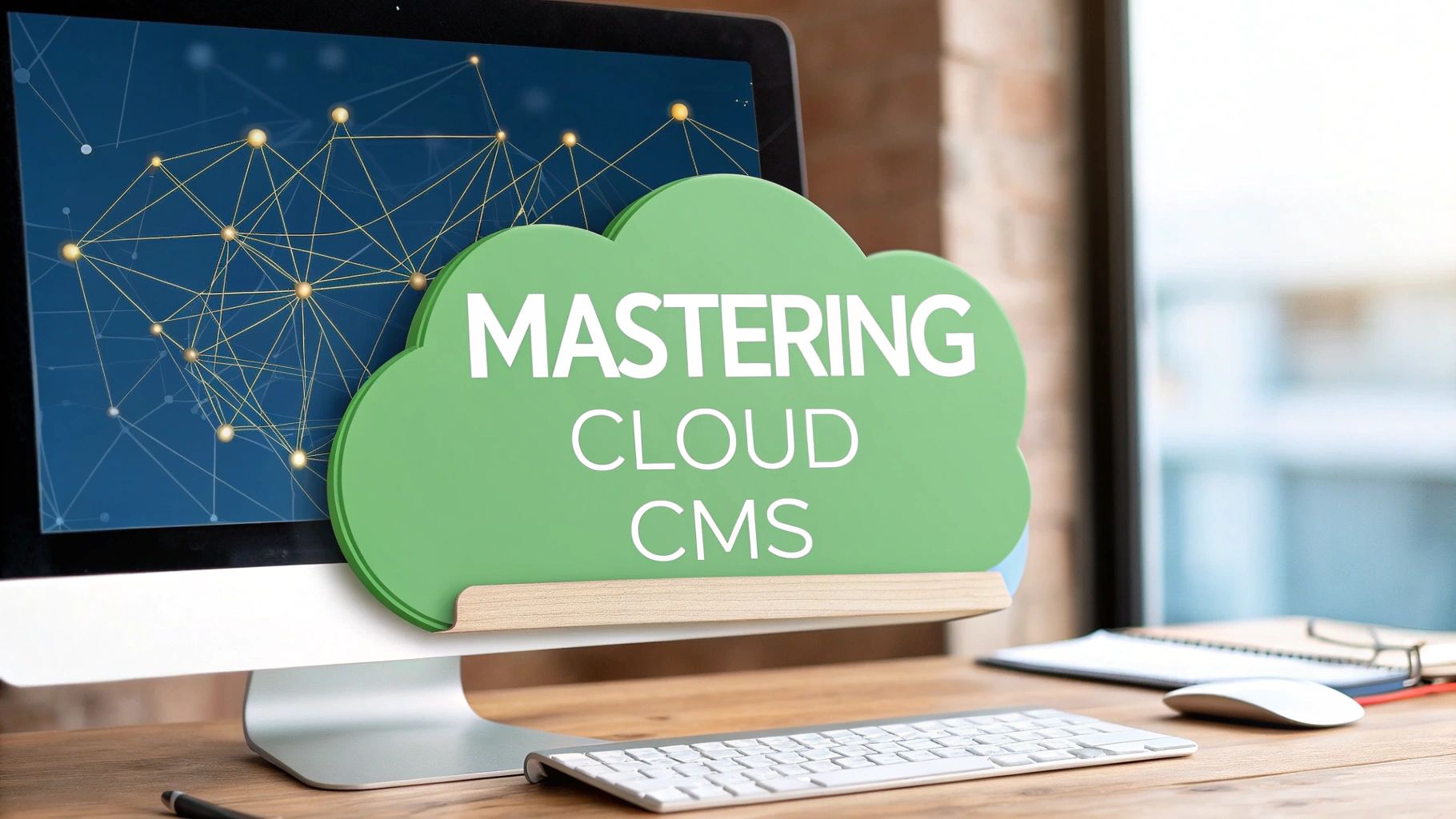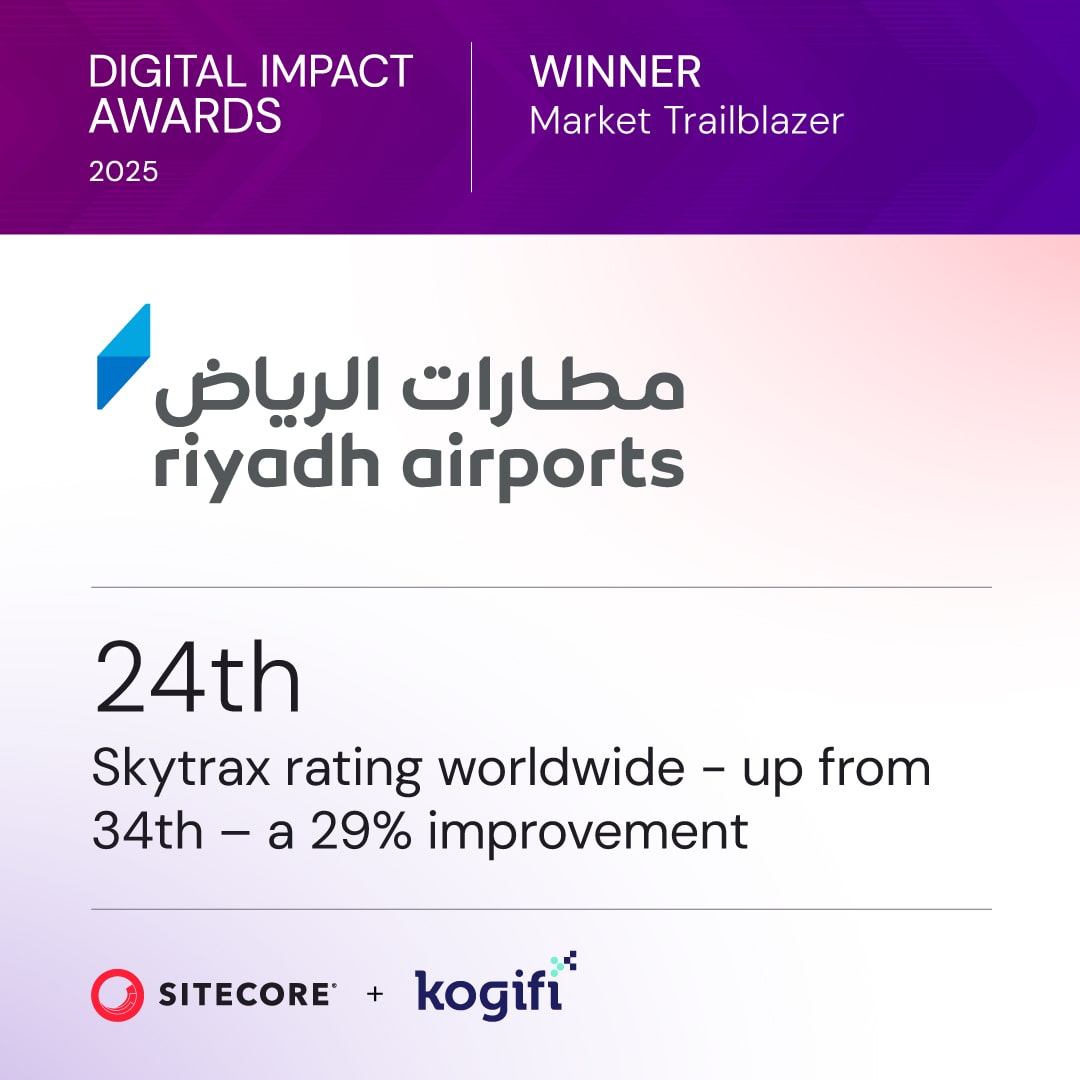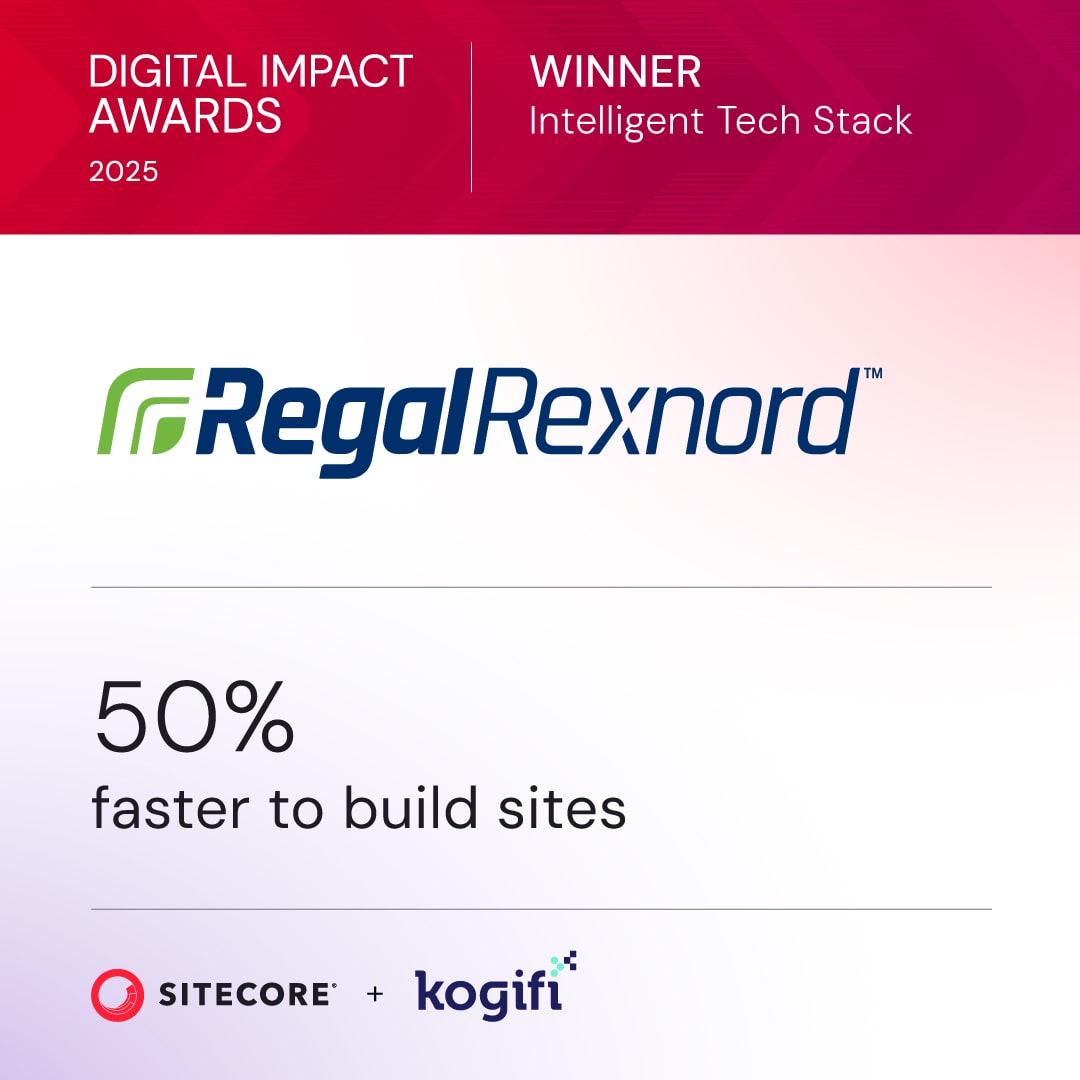When you're looking for the best CMS for enterprise, the conversation usually narrows down to a couple of heavyweights. On one side, you have Sitecore, a master of complex, personalized customer journeys. On the other, there's SharePoint, the undisputed king of internal collaboration.
Picking the right one isn't about finding a single "best" platform. It's about matching a digital engine to what your business actually needs to do—whether that's boosting revenue or making internal operations run smoother.
Choosing Your Enterprise Digital Experience Engine
Choosing an enterprise CMS is a huge decision. It's no longer just about managing a website; it’s a choice that ripples through your marketing agility, customer engagement, and even the day-to-day efficiency of your entire organization. The market has left simple content repositories in the dust, shifting to powerful Digital Experience Platforms (DXPs).
These modern platforms act as the central nervous system for your whole digital strategy. To really get a handle on this shift, it helps to understand what a DXP is and how it's different from a traditional CMS. You can dive deeper in our guide on what is a DXP. For now, we'll focus on two leaders that dominate very different parts of this space.
Understanding the Core Players
At one end of the spectrum, you have platforms like Sitecore. They’re built from the ground up to manage sophisticated, data-driven customer experiences across countless channels. On the other end, you have solutions like SharePoint, which are all about the internal world—providing a secure, integrated hub for document management and team productivity.
The platform you choose will directly shape how well you can future-proof your business. This comparison will lay out a clear roadmap by breaking down the core criteria you need to make the right call.
The global Content Management System market proves just how vital these platforms are. According to market analysis, the industry is projected to grow significantly, driven by enterprise adoption. Enterprises are a huge part of this growth, with many now leveraging CMS platforms for managing complex digital assets and experiences.
Ultimately, the best CMS for an enterprise isn’t just a piece of software; it's a strategic asset. As you weigh your options, it can be helpful to see how other companies tackle these challenges. For a real-world perspective, take a look at Freeform Agency's digital experience solutions to see how these platforms are applied in practice.
Exploring Sitecore's Composable DXP Leadership
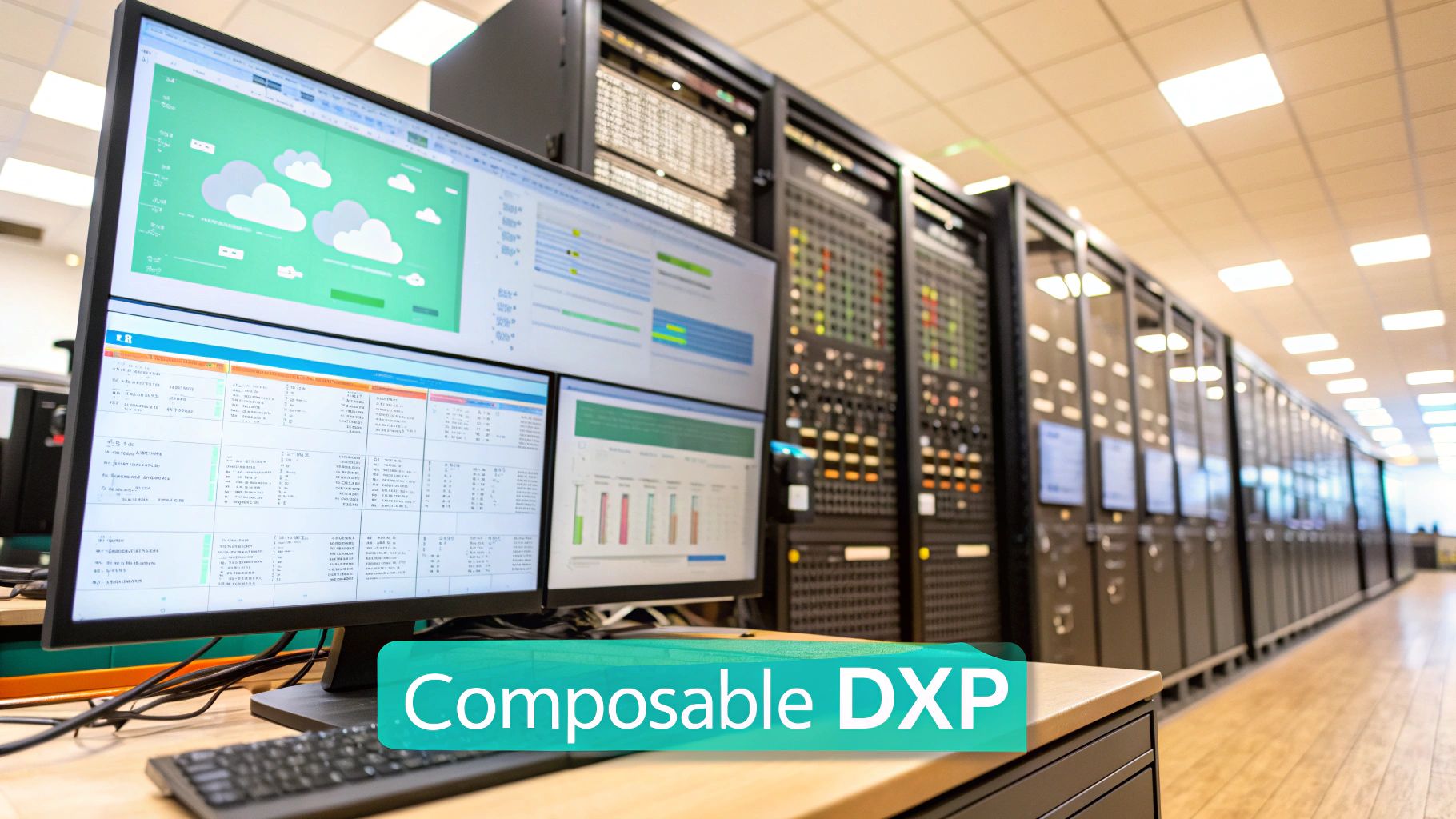
A quick glance at Sitecore's homepage says it all: their focus is on creating unforgettable digital moments. This isn’t just marketing fluff; it’s the core of their entire value proposition and explains their evolution from a traditional CMS into a full-blown Digital Experience Platform (DXP) built for customer engagement.
When the conversation turns to the best cms for enterprise, Sitecore is consistently at the top of the list, especially for companies that live and breathe sophisticated, data-driven customer experiences. They've moved far beyond their content management roots, completely re-architecting their offerings around a composable, MACH-aligned philosophy. This modern approach lets businesses build a flexible tech stack from best-of-breed tools instead of getting locked into a monolithic suite.
This strategic pivot is all about agility. Rather than forcing a one-size-fits-all platform, Sitecore now offers a portfolio of powerful, interconnected products you can adopt individually or together. This modularity is the secret sauce for creating highly customized digital ecosystems that can pivot as fast as the market does.
The Core Components of Sitecore's DXP
To really get Sitecore, you need to understand its product family. Each piece serves a specific role but is designed to work in harmony, delivering cohesive, personalized customer journeys across every single touchpoint.
Here’s a look at the key products in the portfolio:
- Sitecore Experience Platform (XP): This is the foundational, all-in-one DXP. It combines content management with marketing automation, deep analytics, and personalization. It’s a beast of a solution for enterprises that prefer an integrated suite.
- Sitecore Experience Manager (XM) Cloud: Think of this as their world-class CMS, but reborn as a cloud-native, SaaS platform. It delivers incredible agility, automatic updates, and a headless architecture perfect for omnichannel content delivery.
- Sitecore CDP (Customer Data Platform): This is the brains of the whole operation. It pulls together customer data from every online and offline source in real-time, creating a single, actionable view of every individual.
- Sitecore Personalize: Working hand-in-glove with the CDP, this tool leverages AI and machine learning to deliver true 1:1 personalization, A/B testing, and decisioning at scale.
This architecture lets enterprises orchestrate genuinely omnichannel experiences. For example, a global retail brand can use Sitecore CDP to see what a customer does on their mobile app, then use Sitecore Personalize to flash a relevant promotion on the website, and finally follow up with a targeted email through Sitecore Send. You can explore more about Sitecore's powerful DXP capabilities and see how they fuel business growth.
Driving Personalization and Marketing Automation
Sitecore’s real magic is its ability to turn raw data into personalized interactions. Plenty of platforms can segment audiences, but Sitecore's DXP is built for individualization—a critical differentiator for enterprises competing on customer experience.
Imagine a financial institution tracking a visitor who is reading articles on retirement planning. On their next visit, Sitecore’s engine can dynamically swap out the homepage content to feature retirement calculators and wealth management services. The journey feels uniquely tailored to their specific needs.
By unifying content, commerce, and customer data, Sitecore empowers marketers to move beyond generic campaigns and orchestrate truly individualized experiences that build loyalty and drive conversions.
This level of detail is only possible because of the deep integration between its products. The entire journey, from anonymous visitor to loyal customer, is tracked, analyzed, and optimized at every step.
Embracing a Cloud-Native and AI-Driven Future
Sitecore's commitment to a composable, cloud-first strategy couldn't be more in sync with where the industry is heading. A massive shift is underway toward cloud-based enterprise CMS deployments, driven by the need for better scalability, tighter security, and faster feature updates. At the same time, AI is completely reshaping the market by enabling automated content creation and dynamic personalization.
Sitecore's XM Cloud and its SaaS products hit this demand head-on, freeing IT teams from managing infrastructure so they can focus on bigger strategic goals. The AI built into Sitecore Personalize automates the optimization process, ensuring the right message hits the right person at the right time without constant manual tweaking. While a tool like SharePoint excels at internal collaboration, Sitecore is purpose-built to own the external customer journey, making it a top contender for any marketing-led enterprise.
Understanding SharePoint's Digital Workplace Dominance

This screenshot from Microsoft gets right to the heart of SharePoint: it’s a central hub where teams connect, share files, and get work done. The design makes it clear this isn't just about storing documents—it's about building living, breathing digital workspaces.
While platforms like Sitecore own the external customer experience, SharePoint has cemented its rule over the internal enterprise world. It’s more than a content management system. It's a complete digital workplace solutions platform built to organize operations, lock down information, and connect people across massive, complicated companies. This internal focus is precisely why it’s a key contender when evaluating the best cms for enterprise platforms.
SharePoint’s strength isn’t in flashy marketing tools. It’s in its foundational role as the system of record for the enormous flow of a company's internal information—the documents, policies, and collective team knowledge.
Core Functionality for the Modern Enterprise
At its core, SharePoint nails a few critical functions that large businesses simply can't operate without. These features are the bedrock of its value, keeping internal operations efficient and secure.
Its document management is second to none. This is far more than a file drop; we're talking about robust version control, real-time co-authoring, and complex approval workflows. For a global corporation, that means having a single source of truth for compliance documents where every single edit is tracked and every previous version can be recovered.
SharePoint also excels at creating secure intranets and team sites. These are custom digital spaces for departments, projects, or entire regional offices. An HR team can build a one-stop portal for onboarding materials, benefits info, and company-wide news, ensuring everyone gets the same message and can find what they need.
The Microsoft 365 Integration Advantage
SharePoint's real power—what truly makes it dominant in the enterprise—is its seamless, native integration with the rest of the Microsoft 365 ecosystem. It doesn’t work in a vacuum. It’s the content and collaboration backbone for the tools your teams are already using every single day.
This deep connection shows up in a few powerful ways:
- Microsoft Teams: When you create a new team in Teams, a SharePoint site is automatically spun up in the background to handle all its files. This keeps every document shared in a chat or channel centrally stored, searchable, and governed by your company’s rules.
- Power Platform (Automate & Power BI): SharePoint lists and libraries become the data source for sophisticated automations and dashboards. You could, for instance, automate a contract approval process where uploading a document to a SharePoint library kicks off a multi-step review, all without a single manual email.
- Enterprise Search: All the content in SharePoint is indexed and instantly findable through Microsoft Search. An employee can look for a project proposal from their main M365 homepage and immediately find the right document buried deep within a specific team’s SharePoint site.
SharePoint’s deep integration with Microsoft 365 transforms it from a destination into a service. It becomes the invisible fabric that connects content, people, and processes across the entire organization, driving operational efficiency at an immense scale.
Security, Governance, and Compliance
For any enterprise, security isn't just a feature; it's a requirement. This is where SharePoint’s maturity and tight integration with Microsoft Purview give it a serious edge. Admins get incredibly granular control over who can see what, from an entire site collection all the way down to a single file.
Companies in heavily regulated fields like finance or healthcare depend on these features to enforce strict data policies. You can apply retention labels to prevent critical documents from being deleted, use sensitivity labels to encrypt confidential information, and deploy Data Loss Prevention (DLP) policies to block sensitive data from leaving the organization. To see how these features are put into practice, you can explore specialized SharePoint solutions and services that help companies get the most out of the platform.
This powerful framework ensures that as collaboration grows, your security and compliance grow right along with it. While a DXP like Sitecore is built to engage the outside world, SharePoint is engineered to protect the invaluable knowledge inside.
Comparing Sitecore vs SharePoint for Enterprise Use Cases
Trying to decide between Sitecore and SharePoint isn’t about which platform is better—it's about understanding what you’re trying to accomplish. The two operate on completely different philosophies. Sitecore is an engine built to win over and keep external customers, while SharePoint is a framework designed for internal efficiency and knowledge sharing.
Getting this distinction right is the first step in choosing the right tool for the job. One platform is designed to market to the outside world; the other is built to organize the world inside your company.
This infographic cuts straight to their core differences in capabilities, scalability, and how they connect with other tools.
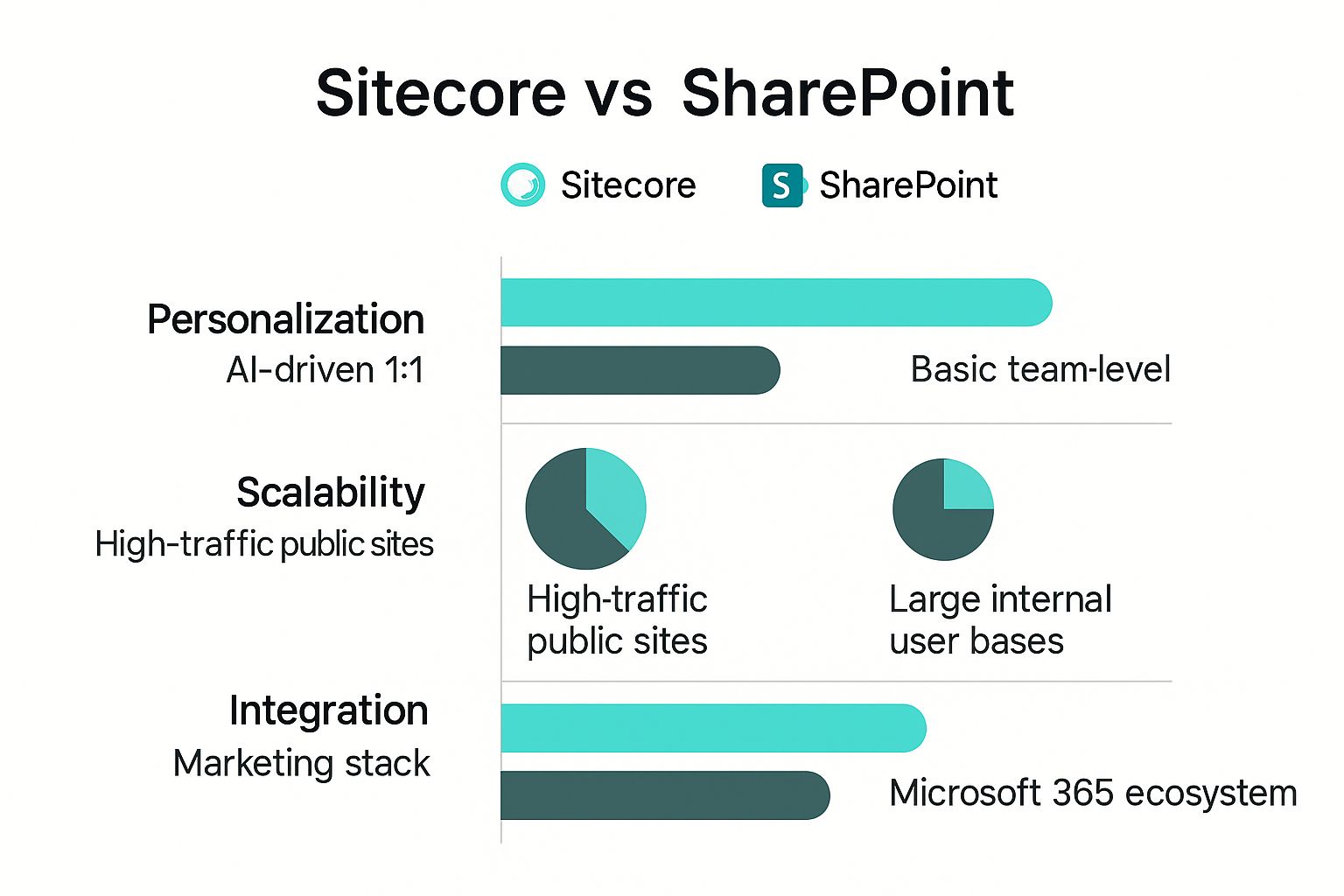
As you can see, Sitecore’s strength lies in AI-powered personalization for public-facing digital properties. SharePoint, meanwhile, shines when it comes to scalable collaboration inside an organization.
Personalization and AI Capabilities
Sitecore's modern, composable stack—especially tools like Sitecore CDP and Personalize—is engineered from the ground up for hyper-personalization. It pulls in real-time behavioral data from every touchpoint, builds detailed customer profiles, and uses AI to deliver true 1:1 experiences. Think of an e-commerce site that automatically reshuffles its homepage categories based on your browsing history—that’s Sitecore’s decisioning engine at work.
SharePoint thinks about personalization in terms of productivity. It’s all about customizing team sites, news feeds, and search results based on an employee's role, department, and recent activity within the Microsoft 365 ecosystem. It’s great at surfacing the right document for an engineer, but it simply doesn't have the native tools to personalize a marketing journey for an anonymous website visitor.
Sitecore’s native AI personalization is a revenue-generation tool designed to influence customer behavior. SharePoint’s personalization is an efficiency tool designed to streamline employee workflows. Achieving Sitecore-level personalization in SharePoint would require extensive and costly custom development.
Scalability and Architectural Focus
When we talk about scalability, context is key. Sitecore is built to handle the unpredictable, high-traffic demands of global websites. Its architecture, especially in a headless setup like XM Cloud, is fine-tuned for lightning-fast content delivery through a global CDN. It can juggle millions of unique visitor interactions and personalization rules at the same time.
SharePoint is a giant of internal scalability. It’s designed to support tens of thousands of employees, manage petabytes of documents, and handle a massive volume of internal collaboration. Its performance isn’t measured in page load times for unknown users, but in its ability to secure, govern, and index a sprawling corporate intranet. For a wider view on how these platforms stack up against others, check out our detailed content management system comparison.
Integration Ecosystems
A platform is only as powerful as the tools it connects to. Sitecore is designed to be the central hub of a marketing technology (martech) stack. It comes with robust, often pre-built, connectors for CRMs like Salesforce, its own e-commerce platform OrderCloud, and various analytics tools. This focus ensures that marketing data flows exactly where it needs to go to drive campaigns.
SharePoint’s integration power comes from its deep, native bond with the Microsoft 365 universe. It’s the content engine behind Teams, Power Automate, and Power BI. This allows for incredibly powerful business process automation—like an expense report submitted in a Power App that automatically archives the receipt in a SharePoint library—all with minimal custom code.
To make the differences crystal clear, here’s a direct comparison of where each platform truly shines.
Core Functionality Deep Dive Sitecore vs SharePoint
This table reinforces the core idea: Sitecore is your go-to for external marketing, while SharePoint is purpose-built for internal operations. Choosing a dedicated tool like Sitecore for customer experience and another like SharePoint for internal operations allows enterprises to leverage best-in-class solutions for each distinct business need, reflecting the trend towards specialized, composable systems.
Which Platform Aligns with Your Enterprise Strategy?
Picking the right enterprise CMS isn't about finding a single "best" platform. It's about aligning a massive technology investment with your most critical business goals. The entire decision boils down to one simple question: is your primary mission to master the external customer journey, or to perfect internal operational excellence?
Your answer immediately points you toward either Sitecore's DXP powerhouse or SharePoint's digital workplace framework. Let's move past feature lists and map each platform to real-world business scenarios. This gives you a clear framework to ensure your choice directly supports what your company is trying to achieve—whether that's driving revenue through killer marketing or boosting productivity with seamless collaboration.
For the Global Marketing Powerhouse
If marketing is your primary revenue engine, the choice is unequivocally Sitecore. This is the reality for global retail brands, financial services firms competing on customer experience, and any organization that needs to run personalized, omnichannel campaigns at a massive scale. The goal isn't just managing content; it's about customer acquisition, conversion, and creating long-term loyalty.
Sitecore's composable DXP is purpose-built for this world. Its real strength is unifying scattered data points into a single, actionable view of the customer.
- Sitecore CDP acts as the central brain, pulling in data from web analytics, mobile app activity, and even in-store purchase history.
- Sitecore Personalize then uses that unified data to make AI-driven decisions, dynamically changing website content, sending targeted emails, and coordinating a consistent message on every channel.
Imagine a global CPG brand. They can use Sitecore to see a user's interest in a product line on their website, then automatically deliver a personalized promotion for that product the next time the user opens their mobile app. That level of orchestration is native to Sitecore's architecture, making it the clear winner for any business where customer experience is the competitive battleground.
For the Operations-Focused Enterprise
When the strategic priority shifts to internal efficiency, knowledge management, and bulletproof collaboration, SharePoint is the obvious leader. This scenario is common in large, regulated industries like manufacturing, engineering, and professional services, where managing complex projects and protecting intellectual property are non-negotiable. Here, the focus is on empowering employees, not marketing to customers.
SharePoint’s dominance comes from its role as the connective tissue inside the Microsoft 365 ecosystem. Its core strengths are a perfect match for operational needs:
- Secure Document Management: It provides a single source of truth for critical documents, complete with version control and granular, user-level permissions.
- Centralized Knowledge Hubs: You can build robust intranets and team sites that become the go-to resource for company policies, project information, and department updates.
- Automated Workflows: It integrates directly with Power Automate to streamline business processes like document approvals, reviews, and data collection.
A large engineering firm, for example, can use SharePoint to spin up a secure project site for a multi-year construction job. This ensures all blueprints, compliance documents, and team communications are centrally managed and only accessible to authorized personnel. This focus on internal governance and productivity makes SharePoint the best CMS for an enterprise driven by operational excellence.
The strategic decision simplifies: Choose Sitecore to manage your external brand experience and drive customer revenue. Choose SharePoint to manage your internal knowledge and drive employee productivity.
The Hybrid Strategy: A Powerful Combination
For many of the world's largest companies, the answer isn't "either/or"—it's "both." A hybrid strategy is the most common and effective approach for massive organizations because it recognizes the distinct, non-overlapping strengths of each platform and uses them together.
In this model, the roles are crystal clear:
- Sitecore owns the public-facing digital ecosystem. It runs the corporate websites, marketing campaigns, e-commerce platforms, and every other customer-facing digital touchpoint.
- SharePoint governs the internal digital workplace. It powers the company intranet, manages all internal documentation, and facilitates secure collaboration between teams.
This dual-platform approach allows an enterprise to use the best-in-class tool for each domain without making any compromises. Marketing teams get the powerful personalization and analytics of Sitecore, while operational teams get the deep security and Microsoft 365 integration of SharePoint. It's the ultimate expression of using the right tool for the right job, aligning technology directly with business function.
Frequently Asked Questions
When you're weighing enterprise platforms, a lot of questions come up. Making a big decision like choosing between Sitecore and SharePoint means getting clear on what each system is really for. Let's tackle some of the most common questions we hear.
Can SharePoint Be Used as a Public Website CMS?
Technically, yes, but it's a terrible idea. SharePoint’s entire architecture is designed for internal use—think secure document libraries, team collaboration sites, and company intranets. Forcing it to act as a public-facing website requires a mountain of expensive custom development just to get basic marketing features off the ground.
If your goal is to engage customers, a real Digital Experience Platform (DXP) like Sitecore is the only practical choice. It comes ready with the tools modern marketers actually need: advanced personalization, A/B testing, marketing automation, and deep customer analytics. SharePoint simply doesn’t have these capabilities in its DNA.
What Is the Total Cost of Ownership Difference?
The total cost of ownership (TCO) for both platforms is significant, and the final number really depends on your specific setup.
- Sitecore's TCO is mostly driven by its licensing fees, which are tied to things like website traffic, features, and the number of environments you need. You'll also need to factor in the cost of a specialized implementation partner and ongoing support.
- SharePoint's TCO can look deceptively low at first, especially since its licensing is often bundled into Microsoft 365 E3 or E5 plans you already have. But the costs balloon quickly with heavy customization, third-party add-ons, and the specialized admins required to keep its complex environment running.
The best way to think about it is this: Sitecore's cost is an investment in revenue-generating marketing. SharePoint's cost is an investment in internal productivity and operational efficiency.
How Does Sitecore’s Composable DXP Approach Differ?
A traditional, all-in-one CMS bundles everything—content, analytics, personalization, e-commerce—into one big, tightly connected platform. This approach works, but it can be rigid and a nightmare to adapt as your needs change.
Sitecore’s composable DXP strategy flips that on its head. It breaks those capabilities into individual, best-in-class products that talk to each other through APIs. This includes standalone tools like:
- Sitecore CDP for unifying customer data.
- Sitecore Personalize for AI-driven optimization.
- Sitecore OrderCloud for headless commerce.
This shift in architecture is a game-changer. You can pick and choose only the tools you need, plug them into your existing systems, and swap out pieces as your business evolves. It gives you the agility to adapt to new market demands without being locked into a massive platform overhaul every few years.
Ready to build a digital experience that drives results? Kogifi specializes in implementing and optimizing powerful DXP and CMS solutions from Sitecore and SharePoint. Our expert teams can help you choose the right platform and architect a solution that aligns perfectly with your business goals. Learn more about our enterprise solutions.
























